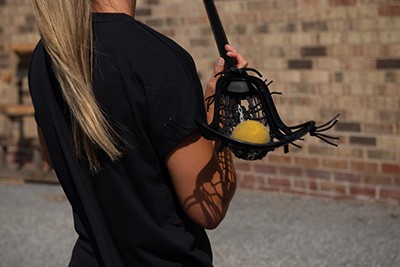Are you a lacrosse player looking to take your game to the next level? Do you find yourself yearning to understand the basics of how to string a women's lacrosse head? Look no further: we've got everything you need for stringing a lacrosse head!
From materials needed to timeline and difficulty estimates - this comprehensive guide will prepare you with the essential knowledge required before your first practice field session.
Now let's get those hands dirty!
More...
Take Away Key Points:
How to String a Women's Lacrosse Stick? A Complete Guide
If you're a beginner women's lacrosse player, you must learn how to string lacrosse heads properly. So, refer to the guidelines below for the best procedure.
Pre-step 1: Materials & equipment needed
Before you start stringing a women's lacrosse head, you will need the correct gear to string a lacrosse head. You will need:
- One lacrosse top string, about 36 inches long
- Two lacrosse sidewall strings, 30 inches per each
- One lacrosse bottom string, around 8 inches long
- Three shooting strings
- A piece of ten diamond mesh
- Scissors to cut off the excess string
- A lighter to melt the ends of cut strings and prevent them from fraying
- Needle nose pliers - to correctly make the strings tight

Pre-step 2: Stretch the lacrosse mesh
Before you start the process of stringing a lacrosse head, you must prepare the lacrosse mesh.
First, make sure you have your mesh appropriately oriented. For example, the top edge has nine diamonds, and the bottom edge has ten diamonds.
In addition, ensure the rougher side of the lacrosse mesh faces inwards. It will add more power to your shorts and perform gripping the lacrosse ball better.
Next, stretch out the lacrosse mesh to its full extent. Do the step before stringing. If not, the mesh will stretch even more after you string it. Your lacing might also sag in certain areas. If you're using a hard mesh, put it in hot water to make it easier to manage.
Once you have stretched the mesh, fold over the top row of nine diamonds. Thus, the holes match up precisely with the second row of diamonds beneath. Now you can start lacrosse stringing.
Main Tips for Lacrosse Stringing

To properly string lacrosse heads, there are some of the most popular tips to use for the process:
Step 1: Stringing a top string
Double-check to ensure the mesh is turned right - the rough side should be turned towards the inside of the lacrosse pocket. Next, take the top string and follow the steps below:
Step 2: Stringing a lacrosse head sidewall
Once you're affirmative that the top string is secure, you can string the sidewall. It would be best to start at the top of the lacrosse head and string your way down the sidewall.
It would be better to string both sides of the lacrosse head sidewall at once. You should tie the first knot on one side, switch to the other, and continue stringing down the lacrosse head.
Stringing both sides of the sidewall ensures consistency and fixation of the stick. Thus, you can affect the creation of the lacrosse pocket positively.
The procedure also allows you to match the tension on both sides and inspect the correctness of your steps. If one sidewall part does not match the other one, you must restring the head and mesh and start over.
As you string the sidewall, the shape of the pocket should appear.
Step 3: Stringing a mid pocket
To ensure an ideal lacrosse pocket, you must be careful when stringing the bottom string and sidewalls. Spacing in these parts or different tensions will create a separate lacrosse pocket.
Ensure you pull the first mesh row of diamonds tight at the top of the lacrosse head. At this point, the mesh will be flatter. When you tighten the first rows, the ball will be released smoothly from the lacrosse stick. The main reason for such an action is the well-shaped channel.
Attaching the diamonds must be more bunched up as you resume lower down the head. Thus, you will get a soft mesh and form a pocket in the middle down the head.
Wet the mesh with warm water to break in the lacrosse pocket. In addition, you should use either the ball or your fist to form the pocket, just as the ball sits in the stick (pocket).
Many lacrosse players secure the ball in the pocket. They jam a stick through the mesh below the sidewalls. You can leave the ball for a few hours or overnight to shape the pocket.
However, you must ensure the pocket depth is legal while playing or practicing. To ensure the legality of a pocket depth, you must place a ball into the pocket.
As long as there is no space above the ball when viewed side-on, your pocket depth, and stick, in general, are legal. Otherwise, you will have to fix the pocket and make adjustments to use the crosse in the game. You might also risk a penalty. Fortunately, you can fix the issues with the deep pockets once you adjust the bottom string.
Step 4: Stringing a bottom string
The bottom string significantly affects the head and the overall performance. Even the slightest adjustments can affect the catching and release of the ball in the game. Thus, the lacrosse string also affects the ball control.
Regarding the method, the bottom string is similar to the top string. Lacrosse players need to weave between the holes at the edge of the head and the bottom row of diamonds.
But, opposite to the top string, you can vary the tension to get the targeted pocket size and shape. This is a crucial step if you want maximum tension.
Adjustments to lacrosse pockets
These are some adjustments that might help you improve your skill levels and become an advanced player.
Step 5: Stringing the shooting strings
The shooting strings weave through the mesh, unlike the other types of lacrosse string. The most common technique includes the straight weave. Different types of string include laced, nylon, rolled, or no shooting strings at all.
Depending on the channel's shape and the pocket, you can experiment with the placement of your shooting strings and adjust them to find the best ball performance in the play.
However, you should lose the closest string to the ball. On the other hand, keep the other string tight as you string the scoop. This is a general rule of the sport.
Remember that the NFHS and NCAA rules do not allow shooting strings more than four inches long from the top of the scoop. Ensure the shooting strings are within this margin, or you might cause an equipment penalty.
Step 6: Trimming the women's lacrosse strings

When you're done with the lacrosse head, you might have left extra string.
Use the scissors to cut off the excess string, but leave an inch or two if you need to make small adjustments later.
Burn the cut ends with the lighter to ensure the ends won't fray but be careful in the process.
Step 7: Testing the strings and the head
You need to test it with your stick laced and ready for the game. Thus, you can check for the correct pocket position and depth. In addition, you can inspect if the positions of the shooting strings work for you.
If you're training alone, use a lacrosse rebounder. On the other hand, if you have a partner, you can practice catches, passes, and shots. It would help to take notes of your overall game to see where you should make adjustments.
Frequently Asked Questions
Do women's lacrosse heads have a mesh pocket?
Yes, women's lacrosse heads also have a mesh pocket starting from 2018.
How do you soften mesh on a lacrosse head?
If you have a new head and mesh pocket, you can use a bucket with hot water and add a tablespoon of fabric softener.
You can leave the new head and the mesh pocket for approximately twenty minutes inside the bucket and then rinse it with water. The detail can read in full article HERE.
What are some popular women's lacrosse stringing styles?
The most popular women's lacrosse stringing styles include:
- STX Exult 500: midfielder
- STX Fortress 600: defender
- New mesh stringing: available from 2018
- Traditional stringing basics: including cross-lace and the leather string
What is the difference between a string women's lacrosse head and a regular lacrosse head?
The main differences between stringing a women's lacrosse head and a regular lacrosse head are the placement of the leather strings, the number of sidewall holes, and the positioning of the mesh.
In women's lacrosse heads, there are fewer sidewall holes, which helps to limit the depth of the pocket for improved accuracy and control.
Additionally, stringers must be careful when stringing women's pockets due to this difference in sidewall design.
Stringers typically place higher and tighter pockets on women's heads than men's because they need to accommodate smaller sticks with fewer sidewall holes.
Summary
Now that you've read about the various techniques and rules of how to string a women's lacrosse head, you have all the information you need to get the most out of your lacrosse-playing experience.
Before every game or practice, make sure you double-check your lacrosse stick and adjust it if necessary. By doing so, you'll be able to reach optimal performance during games or practices.
Additionally, it will help keep you in line with the rules, reducing the chances of penalties during play.
So always remember to check that your women's lacrosse stick is strung correctly - pre-game preparation is key!
